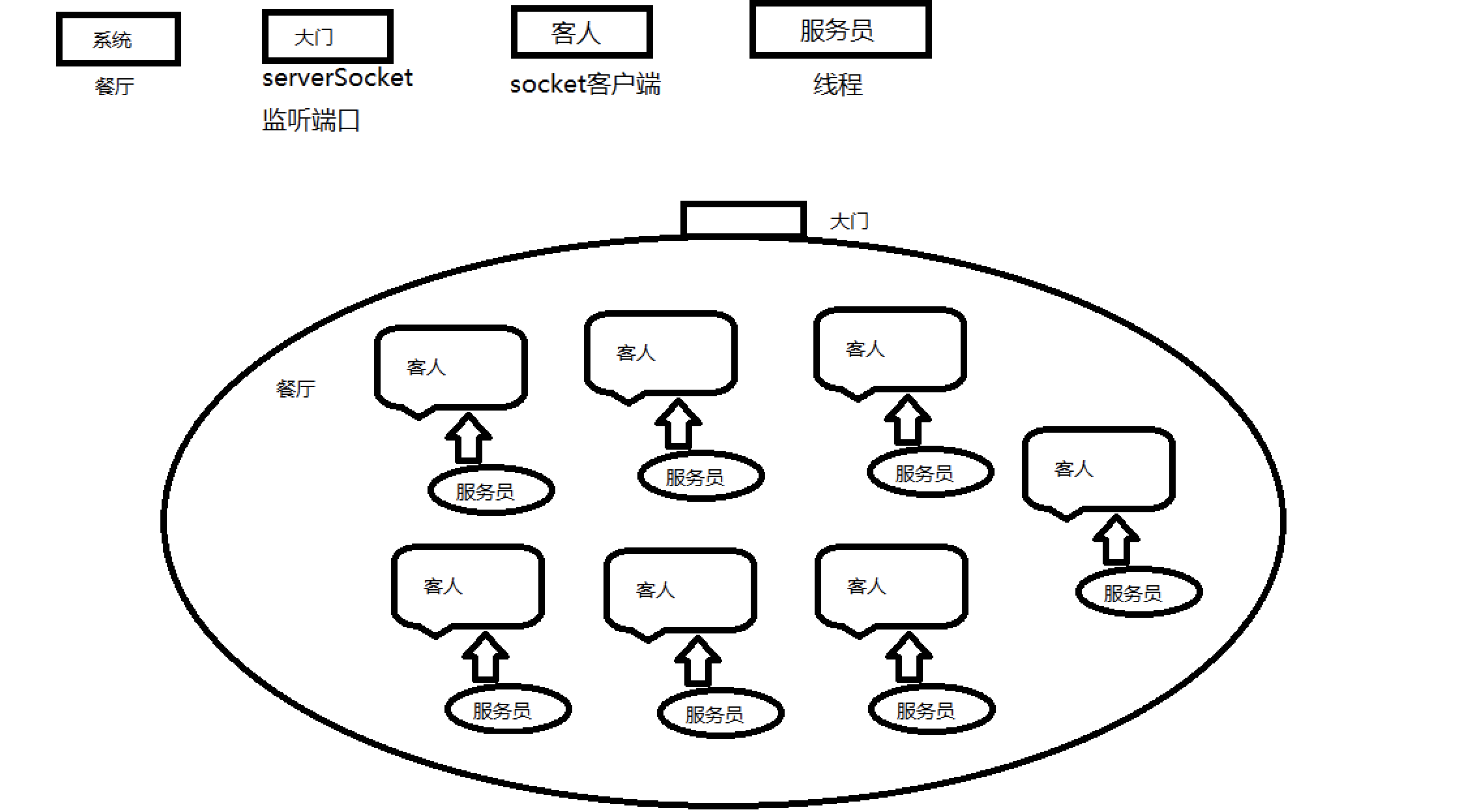傳統IO與NIO比較
我們先來看一段傳統IO的程式碼
public class OioServer { public static void main(String[] args) throws IOException { //這裡可以直接寫成ServerSocket server = new ServerSocket(10101); ServerSocket server = new ServerSocket(); server.bind(new InetSocketAddress(10101)); System.out.println("伺服器啟動"); while (true) { //此處會阻塞 Socket socket = server.accept(); System.out.println("來了一個新客戶端"); handler(socket); } } public static void handler(Socket socket) { try { byte[] bytes = new byte[1024];InputStream inputStream = socket.getInputStream(); while (true) { int read = inputStream.read(bytes); if (read != -1) { System.out.println(new String(bytes,0,read)); }else { break;} } } catch (IOException e) { e.printStackTrace(); }finally { try { System.out.println("socket關閉"); socket.close(); } catch (IOException e) { e.printStackTrace(); } } } }
使用telnet連線
admindeMacBook-Pro:~ admin$ telnet 127.0.0.1 10101
Trying 127.0.0.1...
Connected to localhost.
Escape character is '^]'.
我們會看到OioServer的執行情況
伺服器啟動
來了一個新客戶端
但是當我們又使用一個telnet連線進來的時候,OioServer的執行情況沒變,說明一個服務端只能接收一個客戶端點連線,原因在於Socket socket = server.accept();發生了堵塞,現在我們將其改寫成多執行緒
public class OioServerThread { public static void main(String[] args) throws IOException { ServerSocket server = new ServerSocket(10101); ExecutorService service = Executors.newFixedThreadPool(Runtime.getRuntime().availableProcessors() * 2); System.out.println("伺服器啟動"); while (true) { Socket socket = server.accept(); System.out.println("來了一個新客戶端"); service.execute(() -> handler(socket)); } } public static void handler(Socket socket) { try { byte[] bytes = new byte[1024]; InputStream inputStream = socket.getInputStream(); while (true) { int read = inputStream.read(bytes); if (read != -1) { System.out.println(new String(bytes,0,read)); }else { break; } } } catch (IOException e) { e.printStackTrace(); }finally { try { System.out.println("socket關閉"); socket.close(); } catch (IOException e) { e.printStackTrace(); } } } }
執行可知,當我們啟動了多個telnet進行連線的時候,它是可以一起連線進來的
伺服器啟動
來了一個新客戶端
來了一個新客戶端
但是這裡有一個問題,我們執行緒池的可用執行緒是有限的,不可能無限提供執行緒來接收大量客戶端的連線,遲早它會無響應被堵塞的。
我們現在來看一下NIO,NIO其實是使用傳統IO的特性建立一個channel(通道),通過該通道來註冊事件SelectionKey
SelectionKey有四種事件
- SelectionKey.OP_ACCEPT —— 接收連線繼續事件,表示伺服器監聽到了客戶連線,伺服器可以接收這個連線了
- SelectionKey.OP_CONNECT —— 連線就緒事件,表示客戶與伺服器的連線已經建立成功
- SelectionKey.OP_READ —— 讀就緒事件,表示通道中已經有了可讀的資料,可以執行讀操作了(通道目前有資料,可以進行讀操作了)
- SelectionKey.OP_WRITE —— 寫就緒事件,表示已經可以向通道寫資料了(通道目前可以用於寫操作)
這裡 注意,下面兩種,SelectionKey.OP_READ ,SelectionKey.OP_WRITE ,
1.當向通道中註冊SelectionKey.OP_READ事件後,如果客戶端有向快取中write資料,下次輪詢時,則會 isReadable()=true;
2.當向通道中註冊SelectionKey.OP_WRITE事件後,這時你會發現當前輪詢執行緒中isWritable()一直為ture,如果不設定為其他事件
public class NIOServer { // 通道管理器 private Selector selector; /** * 獲得一個ServerSocket通道,並對該通道做一些初始化的工作 * * @param port * 繫結的埠號 * @throws IOException */ public void initServer(int port) throws IOException { // 獲得一個ServerSocket通道 ServerSocketChannel serverChannel = ServerSocketChannel.open(); // 設定通道為非阻塞 serverChannel.configureBlocking(false); // 將該通道對應的ServerSocket繫結到port埠 serverChannel.socket().bind(new InetSocketAddress(port)); // 獲得一個通道管理器 this.selector = Selector.open(); // 將通道管理器和該通道繫結,併為該通道註冊SelectionKey.OP_ACCEPT事件,註冊該事件後, // 當該事件到達時,selector.select()會返回,如果該事件沒到達selector.select()會一直阻塞。 serverChannel.register(selector, SelectionKey.OP_ACCEPT); } /** * 採用輪詢的方式監聽selector上是否有需要處理的事件,如果有,則進行處理 * * @throws IOException */ public void listen() throws IOException { System.out.println("服務端啟動成功!"); // 輪詢訪問selector while (true) { // 當註冊的事件到達時,方法返回;否則,該方法會一直阻塞 selector.select(); // 獲得selector中選中的項的迭代器,選中的項為註冊的事件 Iterator<?> ite = this.selector.selectedKeys().iterator(); while (ite.hasNext()) { SelectionKey key = (SelectionKey) ite.next(); // 刪除已選的key,以防重複處理 ite.remove(); handler(key); } } } /** * 處理請求 * * @param key * @throws IOException */ public void handler(SelectionKey key) throws IOException { // 客戶端請求連線事件 if (key.isAcceptable()) { handlerAccept(key); // 獲得了可讀的事件 } else if (key.isReadable()) { handelerRead(key); } } /** * 處理連線請求 * * @param key * @throws IOException */ public void handlerAccept(SelectionKey key) throws IOException { ServerSocketChannel server = (ServerSocketChannel) key.channel(); // 獲得和客戶端連線的通道 SocketChannel channel = server.accept(); // 設定成非阻塞 channel.configureBlocking(false); // 在這裡可以給客戶端傳送資訊哦 System.out.println("新的客戶端連線"); // 在和客戶端連線成功之後,為了可以接收到客戶端的資訊,需要給通道設定讀的許可權。 channel.register(this.selector, SelectionKey.OP_READ); } /** * 處理讀的事件 * * @param key * @throws IOException */ public void handelerRead(SelectionKey key) throws IOException { // 伺服器可讀取訊息:得到事件發生的Socket通道 SocketChannel channel = (SocketChannel) key.channel(); // 建立讀取的緩衝區 ByteBuffer buffer = ByteBuffer.allocate(1024); int read = channel.read(buffer); if(read > 0){ byte[] data = buffer.array(); String msg = new String(data).trim(); System.out.println("服務端收到資訊:" + msg); //回寫資料 ByteBuffer outBuffer = ByteBuffer.wrap("好的".getBytes()); channel.write(outBuffer);// 將訊息回送給客戶端 }else{ System.out.println("客戶端關閉"); key.cancel(); } } /** * 啟動服務端測試 * * @throws IOException */ public static void main(String[] args) throws IOException { NIOServer server = new NIOServer(); server.initServer(10101); server.listen(); } }
NIO與傳統IO最大的不同
- NIO有通道的概念,傳統IO沒有這個概念,但通道的概念是基於傳統IO的
- 傳統IO的字元接受處理是也是實用的Java原生的序列化流的方式,而NIO是使用ByteBuffer的緩衝區機制。
使用telnet測試,NIO是肯定支援多個客戶端同時操作的,但很重要的一點是NIO是單執行緒的,傳統IO和NIO的邏輯如下
傳統IO

NIO

至於NIO如何多執行緒,可以參考NIO如何多執行緒操作 ,這其實也是Netty的原理。
分別用兩個telnet連線
admindeMacBook-Pro:IOServer admin$ telnet 127.0.0.1 10101
Trying 127.0.0.1...
Connected to localhost.
Escape character is '^]'.
dsfds
好的
admindeMacBook-Pro:~ admin$ telnet 127.0.0.1 10101
Trying 127.0.0.1...
Connected to localhost.
Escape character is '^]'.
22222
好的
服務端顯示如下
服務端啟動成功!
新的客戶端連線
服務端收到資訊:dsfds
新的客戶端連線
服務端收到資訊:22222
當我們退出其中一個的時候
admindeMacBook-Pro:~ admin$ telnet 127.0.0.1 10101
Trying 127.0.0.1...
Connected to localhost.
Escape character is '^]'.
22222
好的^]
telnet> quit
Connection closed.
服務端顯示如下
服務端啟動成功!
新的客戶端連線
服務端收到資訊:dsfds
新的客戶端連線
服務端收到資訊:2222
